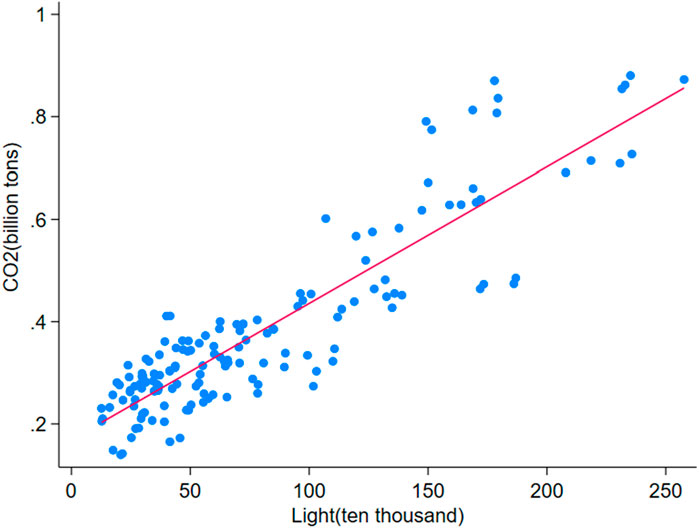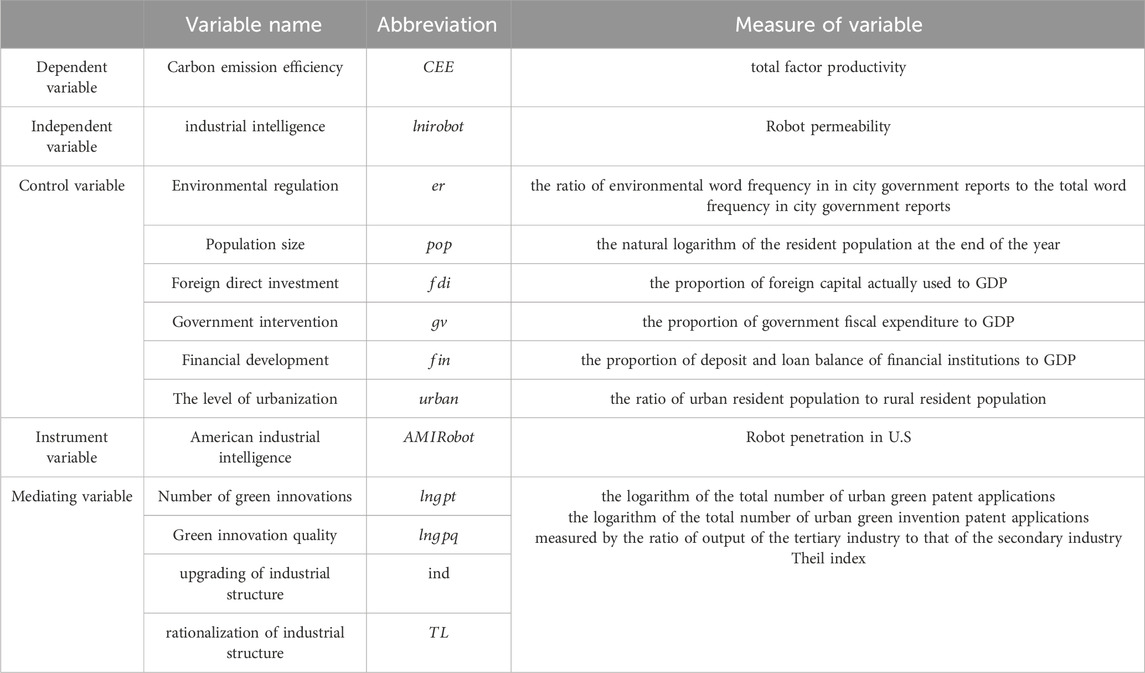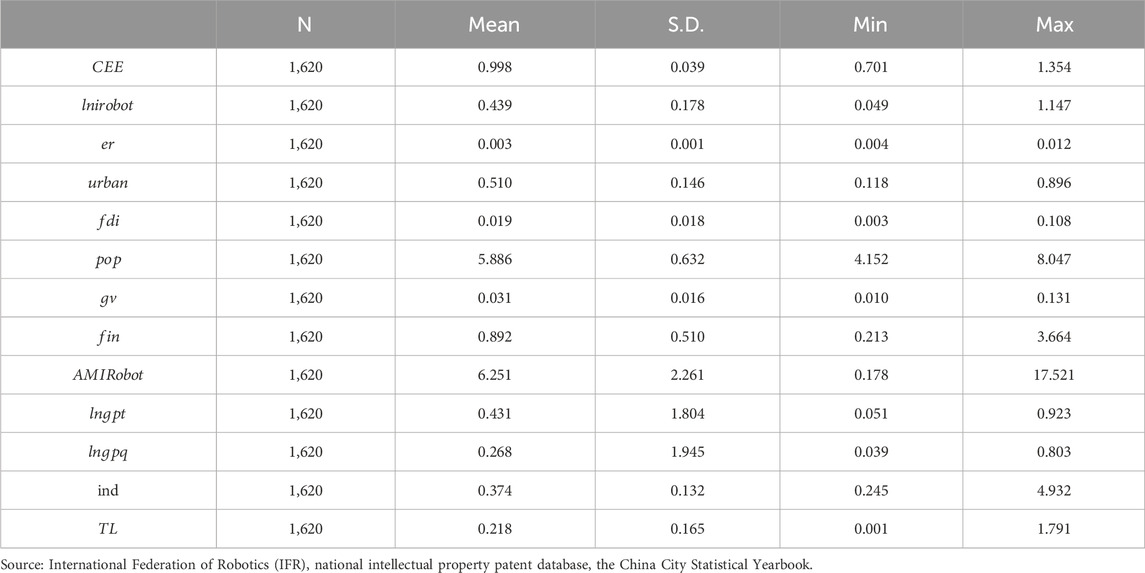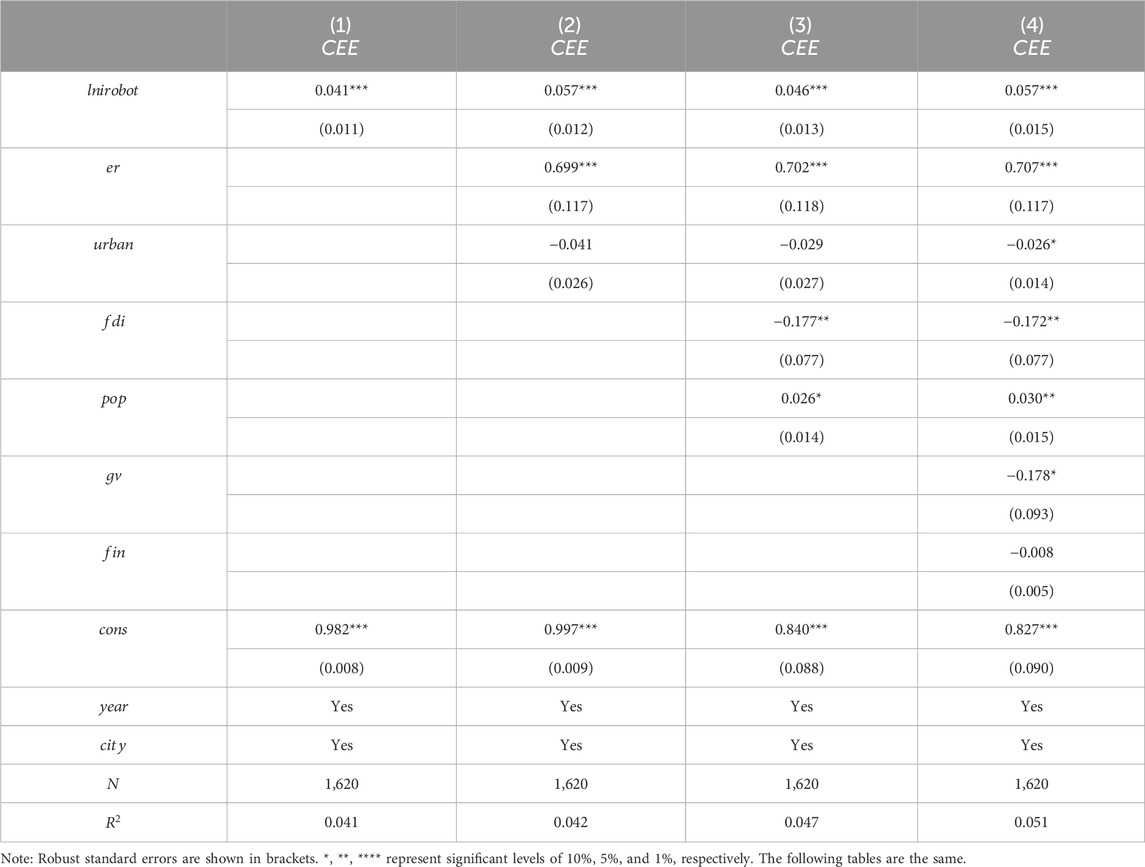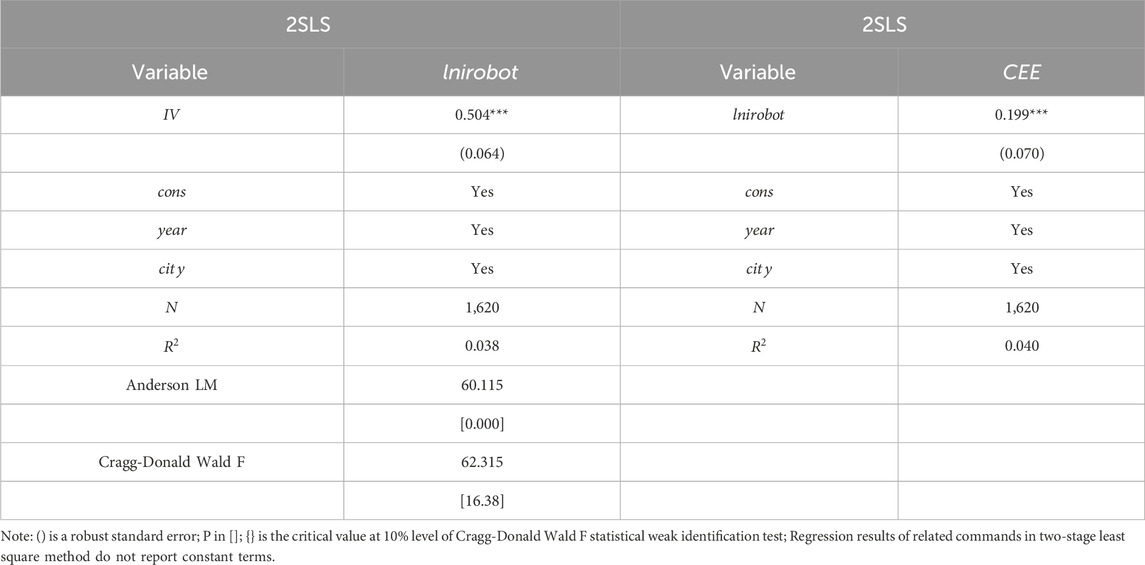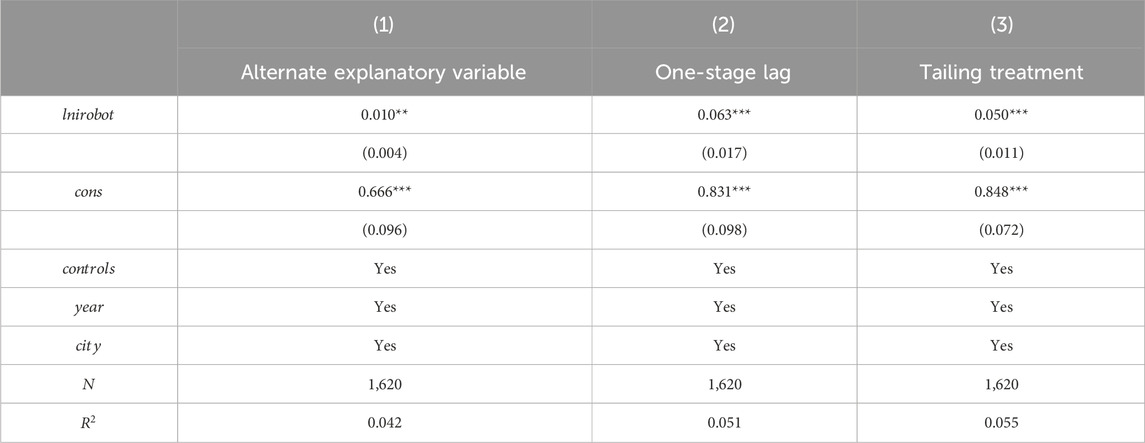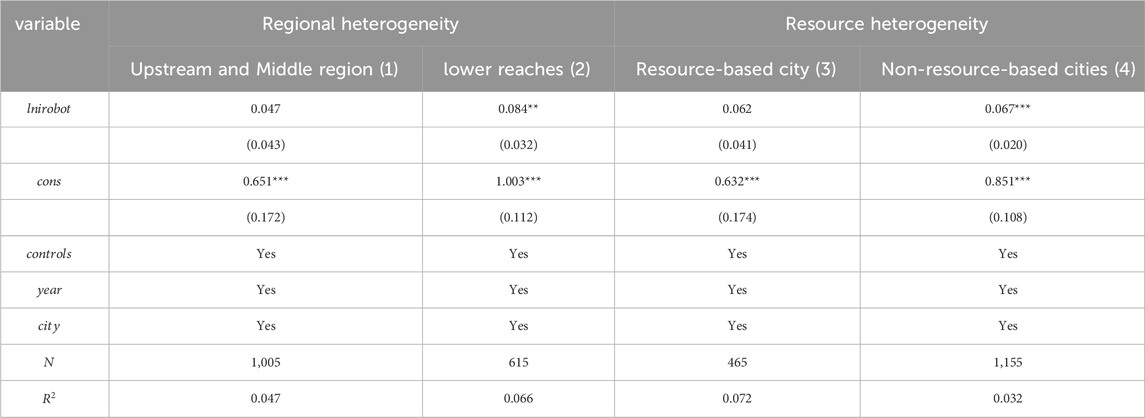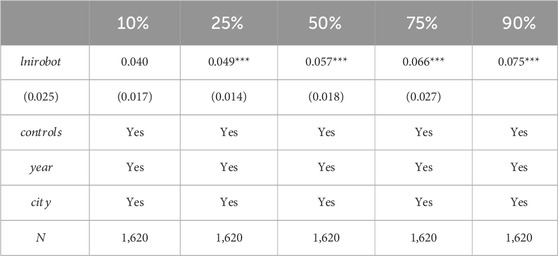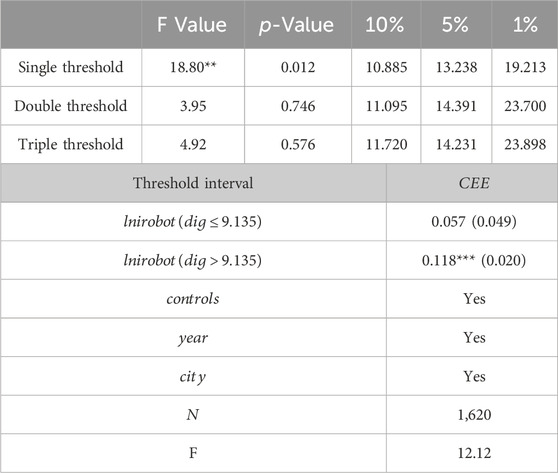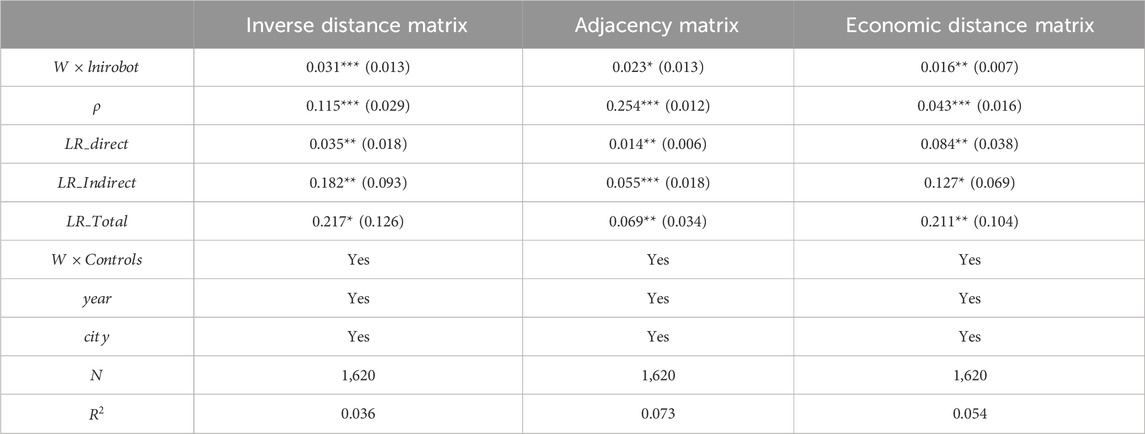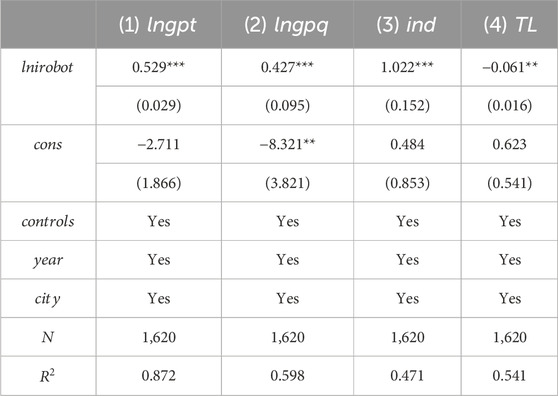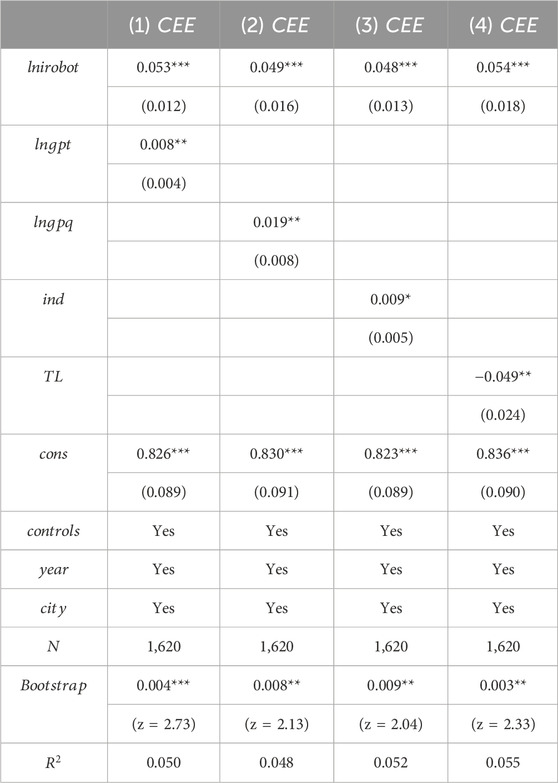- 1School of Economics, Management and Law, University of South China, Hengyang, China
- 2School of Management, China Institute for Studies in Energy Policy, Xiamen University, Xiamen, Fujian, China
- 3School of Economics and Finance, South China University of Technology, Guangzhou, China
The rapid development of intelligent technology characterized by robots under the fourth scientific and technological revolution provides a favorable opportunity for the accurate decision-making of urban pollution control and the effective achievement of the goal of carbon emission reduction in China. This research uses the robot penetration rate as a representative and characteristic index of industrial intelligence development, based on panel data from 108 cities in the Yangtze River Economic Belt (YEB) from 2006 to 2020. It then uses panel quantile regression, spatial measurement, and threshold effect models to provide a more thorough theoretical and empirical discussion of the impact, mechanism, and spatial effect of industrial intelligence development on urban carbon emission efficiency (CEE). Urban CEE may be greatly increased with the use of industrial intelligence, and this finding remains true even after endogeneity and robustness tests are controlled; From an action mechanism perspective, industrial intelligence advances technology, optimizes industrial structure, and ultimately enhances regional CEE; There is a Matthew effect on the degree of development of carbon emission efficiency, and the impact of industrial intelligence on CEE is more pronounced in non-resource-based cities and the lower portions of YEB; Urban CEE increases positively with the spatial spillover impact of industrial intelligence development. The ability for regional sustainable development will be significantly increased if cross-regional cooperative prevention and control of environmental governance can be successfully achieved. This study verifies the enabling effect of industrial intelligence development on the improvement of urban CEE, and provides enlightenment for China to improve industrial intelligence development strategies and policies to achieve regional high-quality development.
1 Introduction
China’s economy has expanded at an average annual pace of 9.4% since the reform and opening up, resulting in “The Chinese miracle”. Yangtze River Economic Belt (YEB) is an important economic region in China, it crosses three Chinese regions and contributes more than 50% of China’s annual economic growth, is a key strategic area for China’s economic development. Nevertheless, the ecological environment of the provinces and cities along the Yangtze River is under peril due to the economy’s fast development. Chinese President Xi Jinping has convened three meetings to emphasize the need to achieve high-quality economic development in China, and Chinese government put forward the commitment of independent emission reduction in the Paris Agreement in 2016 in an attempt to control greenhouse gas emissions. In 2020, China’s carbon emissions per unit of GDP decreased by 48% compared with 2005, exceeding the target of 40%–45% promised to the international community, however, there is still a long way to go. Faced with the increasingly challenging situation of carbon dioxide emission reduction in China, YEB, as a pilot Chinese ecological civilization region and a link for the coordinated development of East, Central and West China, needs to shoulder the dual responsibilities of economic development and environmental protection. That is, to find a green growth path that takes into account both ecological environment and economic growth, and to realize the steady economic growth and “carbon peaking and carbon neutrality” goals. The key to achieving the above goals lies in YEB’s ability to obtain maximum output with minimum material resource input and ecological resource cost, i.e., to improve YEB’s urban carbon emission efficiency (CEE), which is directly related to the implementation of the national High-quality economic development and the realization of the future “carbon peaking and carbon neutrality” goals.
At this stage, a significant industrial intelligence development trend has emerged globally, which has a revolutionary effect on the economic activities of enterprises. This trend is brought about by the ongoing breakthroughs in information and communication, new materials, new energy (Graetz and Michaels, 2018). The White Paper on China’s Industrial Intelligence in 2019 points out that industrial intelligence is the output increment brought by the use of artificial intelligence (AI), Internet of Things, Internet and other technologies in the primary, secondary and tertiary industries. It liberates manpower by replacing simple repetitive work, provides a brand-new human-computer interaction mode, and breaks through the limits of human beings to innovate new industrial species. It can be said that industrial intelligence is essentially subverting people’s production and lifestyle. Through the automation of knowledge work, man-machine interaction and collaborative intelligence in product life cycle manufacturing activities, it realizes the optimization of product life cycle manufacturing process, thus promoting the optimization of industry factor endowment conditions and the innovation of production mode, and inevitably having a noticeable impact on urban CEE as the carrier of economic activities and industrial space. As a result, the widespread application of smart technologies in the industry holds great promise for the Chinese region to achieve the sustainable development goals (Vinuesa et al., 2020). It makes sense to bring the realistic background of industrial intelligence development into the policy consideration of improving the path of CEE, deeply reveal the influence effect and internal logic of industrial intelligence development on CEE, and discuss how industrial intelligence development can promote CEE.
2 Literature review
With the rise of Industry 4.0 Revolution, the impact of industrial intelligence on economy and society has aroused extensive discussion in academic circles (Goralski and Tan, 2022), and related research has produced substantial results on the economic growth effect and environmental impact effect of industrial intelligence respectively. Regarding the impact of industrial intelligence on economic growth, existing studies have come up with consistent and positive findings on the features of industrial intelligence that foster efficiency enhancement, technical innovation, and industrial revolution. For instance, labor can be supplemented and replaced in repetitive tasks and standardized processes by integrating artificial intelligence with manufacturing (Mikalef and Gupta, 2021); Labor productivity may be promoted to support economic growth, and intelligent production and management can be achieved by optimizing production control decisions through independent control (Kromann et al., 2020). Industrial intelligence can contribute to economic development by reshaping innovation processes, increasing the capabilities of R&D organizations and generating spillover effects through the application sector (Ding et al., 2023). Jin et al. (2022) pointed out that the application of artificial intelligence technology in greenhouse planting can predict greenhouse meteorological data, accurately guide agricultural production and reduce unnecessary production costs. Industrial intelligence brings intelligent industrialization innovation and industrial intelligence transformation, and at the same time, it can promote the intelligent reconstruction of industrial structure (Guo, 2019); The deep integration of artificial intelligence and traditional industries promotes the digital and intelligent transformation of traditional industries, accelerates industrial differentiation, and promotes the cross, penetration and integration of different industries (Graetz et al., 2022). However, some scholars have also put forward the adverse effects of industrial intelligence on economic growth, including labor market crowding out (Wang et al., 2022), unemployment (Acemoglu and Restrepo, 2019), blind expansion (Zhao et al., 2022) and so on.
Existing studies mainly used the Divisia index method to decompose carbon dioxide emissions in order to analyze the factors affecting carbon emissions (Raza et al., 2021), or mainly studied the impact of the traditional production factors on carbon emissions (Raza and Lin, 2022; Raza and Li, 2023). The current study on the effects of industrial intelligence on the environment is mainly focused on the industrial sector. It has conducted both theoretical and practical research on the potential avenues through which industrial intelligence could support low-carbon and green development, with a focus on energy efficiency enhancement, innovation in green technologies, and industrial structure optimization. It is believed that industrial intelligence can integrate intra-industry and inter-industry knowledge and cross-enterprise cooperative innovation (Barbieri et al., 2020), and accelerate knowledge spillover and creation; Promote the absorption and creation of knowledge within enterprises, optimize the decision-making of equipment and materials use (Zhang et al., 2023). The application of artificial intelligence in the industrial field helps to improve energy efficiency and reduce related pollutants (Sarkar and Sarkar, 2020). According to Yuan et al. (2022), industrial intelligence has the potential to enhance production processes, provide real-time feedback and optimization of production information, minimize energy waste, shorten equipment response times, and drastically close the gap between companies and the most energy-efficient ones; Neural network and machine learning applications can forecast waste production and encourage waste recycling, increasing energy efficiency and lowering emissions of pollutants (Kopka and Grashof, 2022). Additionally, the use of industrial intelligence can help modernize and restructure the industrial structure, advance the growth of clean industries, and remove outdated production capacity (Shen and Yang, 2023); The energy industry may effectively foster the growth of new energy industries, decrease industrial pollution emissions (Du et al., 2021). Some scholars have reservations about whether industrial intelligence can improve the environment. The reason is that although artificial intelligence technology is developing rapidly, only some regions and a small number of enterprises have matching human capital and corresponding intelligent infrastructure at present. In addition, the lag of technology diffusion and the formation of social group consciousness take a long time, which easily makes the production efficiency improvement brought by artificial intelligence technology not obvious, and even crowds out the investment of other departments and easily causes unnecessary waste of resources (Du and Lin, 2022; Liu et al., 2022). In the long run, these regions with relatively backward basic conditions cannot share the knowledge dividend brought by artificial intelligence technology equally, which hinders the green development of regional economy, and eventually leads to the Matthew effect that the stronger the strong and the weaker the weak. According to Czarnitzki et al. (2023) and Liu et al. (2020), industrial intelligence has a “U-shaped” impact on economic intense transformation. Some experts believe that human conduct has a crucial part in determining the direction of environmental change, and that the application mode of industrial intelligence affects this.
In summary, Research exploring the environmental impact effects of industrial intelligence needs to be fleshed out as the trend towards industrial intelligence increases globally; furthermore, existing research has focused mainly on the environmental impacts of intelligent developments in the industrial sector. However, the problem of carbon emissions from primary and tertiary industries in China is equally serious. For example, from 2011 to 2018, China’s tertiary industry carbon dioxide emissions increased by 51.24%, and total agricultural carbon emissions accounted for 17% of total greenhouse gas emissions, higher than the global average of 11% (Gai and Yang, 2023). Because of the numerous problems caused by the depletion of global resources and the mounting demand on enterprises to reduce carbon emissions, it is therefore not sufficient to examine the effects of industrial intelligence on productivity, economic growth, and carbon emissions in isolation. Therefore, even if the secondary industry, including the industrial sector, is the main source of carbon emissions, the growth of carbon emissions from other industries cannot be ignored. It is imperative to study how industrial intelligence affects carbon emission from the perspective of coordinated development of various industries. The theory and methodology of the green total factor productivity (GTFP) index in environmental economics are based on the TFP. GTFP is a significant indicator of the joint performance of economic growth and environmental optimization, represents the ability of the economic system to generate economic output while maintaining environmental quality and ecological balance through production factors like labor, capital, and energy (Zhan and Li, 2022). Only Tang and Chi (2022), Meng and Zhao (2023), and Qian et al. (2023) have examined the connection between industrial intelligence and green economic efficiency in the literature that is now in existence. This relationship has to be further refined.
For the reasons listed above, the penetration rate of industrial robots is used in this article as a representative and distinctive indicator of the growth of industrial intelligence, and conducts a theoretical and empirical analysis on the impact and mechanism of CEE of cities empowered by industrial intelligence, based on panel data of 108 cities in Chinese YEB from 2006 to 2020. The possible marginal contributions of this research include: Firstly, this research enriches the research on the relationship between industrial intelligence and the coordinated development of economy and environment, and provides theoretical and empirical evidence from China for exploring the path of improving urban CEE from the perspective of digital technology. Secondly, this research analyzes the heterogeneous impact effect of industrial intelligence on CEE in YEB from the perspectives of geographical location, resource endowment and CEE, and provides more detailed empirical conclusions for policy recommendations. Thirdly, this research verifies the spatial spillover effect of industrial intelligence on urban CEE, and provides theoretical support for the implementation of cross-regional pollution control policies. Fourthly, this research discusses the threshold effect of human capital on the impact of industrial intelligence on CEE, which has important policy implications for breaking the “Matthew effect” between regions and giving full play to the role of human capital in environmental governance. Section 2 is literature review. Section 3 elucidates the theoretical analysis and provides research hypotheses. Section 4 details the methodologies and variable descriptions. Section 5 presents the empirical results. Section 6 is the discussion of empirical results. Section 7 provides conclusion, policy implications and limitations.
3 Mechanism analysis and hypothesis
3.1 Analysis of the direct impact of industrial intelligence on urban CEE
Technologies such as machine learning, intelligent robots, computer vision, and deep learning are important forms of artificial intelligence (Liu et al., 2020). With the free flow of cross-border capital in recent years, the application of artificial intelligence technology in industries in emerging economies has been accelerated (Ma et al., 2023). The application of artificial intelligence in the primary industry can transform the traditional production mode of agriculture into an intelligent production model, realize precision planting and breeding, and achieve the goal of low-carbon agricultural development. The integration of artificial intelligence and manufacturing will help break through the limitations of manual supervision process, realize the digital control of the whole production process, and reduce the greenhouse gas emissions of the entire industrial chain (Wang et al., 2023). Industrial intelligence can also optimize urban industrial production conditions, improve the purification accuracy of waste through robot operation, and provide a more scientific and effective basis for enterprise pollution control decisions through pollution data mining and analysis. The application of artificial intelligence technology in the tertiary industry can reduce the carbon emissions of transportation and life services, and improve the CEE of the tertiary industry. Therefore, the following assumptions are put forward:
H1. Industrial intelligence can promote the improvement of urban CEE.
3.2 Analysis of the indirect impact of industrial intelligence on urban CEE
3.2.1 Analysis of technological progress channel
The endogenous growth theory states that the advancement of technology is the primary driver of steady economic growth, and Grossman and Krueger (1991) confirm the key role of technological effect in improving environmental pollution. In the context of industrial intelligence, the traditional labor force is liberated from tedious process work to focus on innovation as well as more valuable strategic activities (Li, 2023), the use of intelligent equipment often requires a high level of knowledge, prompting enterprises to introduce high-quality talent, and to achieve scientific and technological progress through the human capital effect and technological complementary effect (Yu et al., 2022). In addition, AI technology can reduce the cost of information transfer between enterprises, enable enterprises to learn and imitate advanced production technology, expand the capital stock of public knowledge, and drive the technological innovation of upstream and downstream enterprises (Nishant et al., 2020). The use of intelligent technology enables enterprises to continuously improve the added value of their products and gradually replace low value-added enterprises in the industrial value chain, while other enterprises that have not undergone intelligent transformation will continuously update their production technology and management experience through learning and imitation in order to avoid being eliminated (Bernard et al., 2019). Urban industrial energy efficiency can be effectively increased through technological advancements in the areas of industrial resource recycling efficiency, green technology and equipment product supply, and green transformation level of production process. Therefore, the following assumptions are put forward:
H2. Industrial intelligence promotes urban CEE through the channel of technological progress.
3.2.2 Analysis of industrial structure optimization channel
In the process of the intelligent development of industry, digital technology and digital elements are widely applied in all fields of cities’ economy and society, and the rapid development of modern information technology promotes the deepening of the integration of the digital economy and the real economy, giving rise to a series of new products, new technologies and new forms of business, and promotes the continuous upgrading of the industrial structure in the direction of high-end digitization, greening and low-carbonization (Furman and Seamans, 2019). In addition, industrial intelligence can prompt traditional industrial enterprises to gradually eliminate backward production capacity and carry out transformation and upgrading, which is not only an important path to break the dilemma of high pollution, high energy consumption and high emission in the field of industrial economy, but also a typical feature of the optimization and upgrading of industrial structure (Waltersmann et al., 2021). Industrial structure upgrading in the process of industrial intelligent development can accelerate the development of greening and low-carbonization in the whole field of social economy and realize the improvement of CEE. Therefore, this research proposes the following research hypothesis.
H3. Industrial intelligence promotes urban CEE through the channel of industrial structure optimization.
3.2.3 Spatial effect analysis
According to the theory of economic geography, the flow of production factors can gradually break down interregional market segmentation and change the spatial isolation of individual development. This leads to a certain spatial spillover effect in interregional production activities. Digital technologies such as artificial intelligence and big data carried by industrial intelligence can break the geographical distance barrier of information technology transmission, improve the mobility and accessibility of data, and alleviate the barriers of technical exchange between regions, which makes the regions that actively improve the level of industrial intelligence have certain enlightening and learning effects on neighboring regions after achieving economic growth and environmental protection achievements (Vial, 2019), thus promoting the improvement of CEE in neighboring regions. If the spatial spillover effect is disregarded, the overall benefit of industrial intelligence on CEE may be underestimated. Based on this, this research proposes the following research hypothesis.
H4. Industrial intelligence may have spatial spillover effects on carbon efficiency in neighboring regions.
4 Methodology and variable definitions
4.1 Model setting
The empirical research in this paper aims to effectively identify the impact of industrial intelligence on urban CEE, so we set the following benchmark regression model based on the above theoretical mechanism analysis and research hypotheses:
Where
To further discuss the spatial spillover effect of urban industrial intelligence on urban CEE, the spatial interaction terms of the explanatory variables are introduced into Eq. 1 to construct the following spatial measurement model:
In Eq. 2,
4.2 Variable definitions
4.2.1 Core explanatory variable: urban industrial intelligence level (
Referring to the methods of Acemoglu and Restrepo (2019), Xu and Song (2023), this research construct the robot application index at the city level using the industrial employment structure of the city, the number of working-age laborers in the city and the number of robots at the industry level. This method comprehensively considers the characteristics of urban labor force, the scale characteristics of industrial labor force and the application scale of urban robots, and is more scientific compared with the direct use of the robot data. Specific measurement formula is shown in Eq. 3:
In Eq. 3,
4.2.2 Explained variable:
Referring to the existing literature (Sun and Huang, 2020; Yu and Zhang, 2021), this research adopts total factor productivity (TFP) to measuring
Due to the lack of detailed urban energy consumption data, this research draws on the methodology of Chen et al. (2020) and uses NPP-VIRS nighttime lighting data to derive carbon emission data for Chinese cities. In recent years, measuring carbon emissions based on NPP-VIIRS night light data has been widely used in economic research (Zhang et al., 2019; Ismael, 2021). The basic logic is that the higher the brightness of lights at night, the more active the city’s night-time economic activities are, and the higher the energy consumption will be. Specifically, considering the accuracy of the downscaling model inversion, a linear model is adopted to fit the carbon emission data, and the results of the correlation test between the carbon emission estimates and the statistical values of each province are shown in Figure 1. There is a linear correlation between carbon emission estimates and statistics, and the goodness of fit
4.2.3 Tool variables: U.S. Robot use
Considering that cities with higher
4.2.4 Control variables
Referring to relevant studies (Du et al., 2022; Huang et al., 2023), this study includes the following control variables. Environmental regulation
4.2.5 Mechanism variables
In accordance with the above analysis, the mechanism effects of this research mainly include technological progress and industrial structure optimization. Technological progress variables are expressed as the number of green innovation
4.2.6 Data sources
The robot data comes from International Federation of Robotics (IFR), a database that shows the annual increase and inventory of robots in manufacturing, agriculture and certain service industries in 75 countries. Other variables were derived from the National Intellectual property Patent database and the China City Statistical Yearbook.
5 Analyses and empirical findings
5.1 Baseline regression analysis
Table 4 displays the results of the baseline regression. It is evident from columns (1) to (4) that industrial intelligence positively affects urban CEE in YEB, and the effect is significant at the 1% significance level, proving that industrial intelligence can significantly promotes urban CEE, and Hypothesis 1 is confirmed.
5.2 Robustness test
5.2.1 Endogenous treatment
This research takes the U.S. robotics data measured in Eq. 4 as an instrumental variable for the regression, and the results are shown in Table 5. The Anderson LM test is significant at the 1% level, and the value of Cragg-Donald Wald F statistic is 76.364, which is greater than the critical value of 16.38 corresponding to the maximal IV size at the 10% critical value of the Stock-Yogo test, so it can be considered that this instrumental variable is appropriate. After considering endogeneity, the second-stage regression results show that the regression coefficient of the impact of industrial intelligence on urban CEE is significantly positive at the 1% significance level, which is consistent with the baseline regression results but larger than the baseline regression coefficients, which indicates the robustness of the baseline regression results, and suggests that failing to take into account endogeneity underestimates the effect of industrial intelligence on urban CEE.
5.2.2 Alternate explanatory variable
We re-run the regression using the incremental robot data as explanatory variables. Logically, if the stock of robots in the urban industrial subsector can have a positive impact effect on the urban CEE, the incremental robots in the urban industrial subsector can have a positive effect as well. The International Federation of Robotics (IFR) reports both the stock data and incremental data of robot use in China. The regression results are shown in column (1) of Table 6. After regressing with incremental data as an explanatory variable, the coefficient value is still significantly positive, indicating the robustness of the benchmark regression results.
5.2.3 Lagging one-stage regression treatment
Considering that there may be a time lag in the role of industrial intelligence in improving CEE in cities, the following regression is conducted with the core explanatory variables of urban robot application rate lagged by one period, and the results are shown in column (2) of Table 6. The coefficient value in front of the explanatory variables is still significantly positive, which verifies the robustness of the baseline regression results.
5.2.4 Tailing treatment
In order to exclude the influence of extreme outliers, this research shrinks all the extreme outliers of continuous variables at the upper and lower 1%, and then reruns the regression estimation, and the results are shown in column (3) of Table 6, which shows that industrial intelligence positively influences urban CEE at the 1% significance level, verifying the robustness of the baseline regression results.
5.3 Heterogeneity analysis
5.3.1 Regional heterogeneity analysis
The YEB in China is a vast area, and each city has different degrees of economic development and industrial intelligence development level. For example, Zhejiang, Jiangsu, Anhui, Shanghai in the downstream area of the YEB are the largest digital economy regions in China, with the scale of the integrated circuit industry accounting for 58.3% of China, and their AI industry accounting for 33.0% of AI industry in China. Furthermore, the market competition in the downstream area of YEB is better with fewer constraints to the development of industrial intelligence compared with other areas of YEB. Therefore, this research then divides the samples into two sub-samples of upstream and midstream, downstream regions to investigate the regional heterogeneity of the impact of industrial intelligence on urban CEE in YEB, and the results are shown in Columns (1) to (2) of Table 7. The results show that industrial intelligence in the upstream and midstream regions of the YEB does not have a significant effect on urban CEE, but industrial intelligence in the downstream region of the YEB significantly and positively improves urban CEE.
5.3.2 Resource endowment heterogeneity analysis
We then divide the samples into resource cities and non-resource cities to investigate the differential impact of industrial intelligence on CEE in YEB under the condition of heterogeneity of resource endowment, and the results are shown in Columns (3) to (4) of Table 7 It shows that the impact coefficients of industrial intelligence on the non-resource cities are significantly positive, and the impacts on the resource cities are not significant. The reason may be that, the economic growth of resource cities relies heavily on value-added, low technological level and high energy consumption based on the theory of “resource curse” and “comparative advantage trap”, which restricts the enhancement of CEE of resource cities in the YEB empowered by industrial intelligence.
5.3.3 CEE heterogeneity analysis
We then use panel quantile regression to test the heterogeneous effect of urban industrial intelligent development on CEE at different CEE levels. Table 8 shows that the regression results are not significant only for the samples at the 10% quartile level, which indicates that the development of industry intelligent has a positive effect on the improvement of urban CEE in most cases. Moreover, there is a “marginal increase” in the impact coefficient as the quartile rises, that the estimated coefficient at the 25% quantile is significantly smaller than the estimated coefficient at the 90% quantile, which indicates that the empowering effect of industrial intelligence is more obvious for cities with higher levels of CEE, and there is the “Matthew effect” of carbon reduction in cities.
5.4 Expanded research
5.4.1 Threshold effect analysis
We then take the level of urban digital human capital as a threshold variable to further explore the threshold effect of industrial intelligence on CEE in the YEB. Specifically, the number of employees in the sectors of information transmission, computer services and software are used to measure urban digital human capital. The results in Table 9 show that when the level of digital human capital is lower than the threshold value of 9.135, the CEE effect brought by industrial intelligence is not significant, when the level of digital human capital is greater than the threshold value of 9.135, the regression coefficient is 0.118 and passes the test of 1% significance level. It can be seen that there is a digital human capital threshold for the CEE effect of industrial intelligence in YEB, and industrial intelligence has a significant positive effect on CEE only when it crosses the threshold of digital human capital, and the effect value will show an upward trend with the improvement of the digital human capital level.
5.4.2 Spatial spillover effect analysis
We further explore whether the effect of industrial intelligence on urban CEE in YEB has spatial spillover effects. We first test the spatial autocorrelation of industrial intelligence and urban CEE variables. The
5.5 Mechanism analysis
Based on the above theoretical analysis and hypothesis, this research examines the mediating mechanisms through which industrial intelligence affects urban CEE from the perspectives of technological progress and industrial structure optimization, respectively. We set up the mediated effect test model as shown in Eqs 5, 6:
1. Mechanism test of technological progress. Theoretically, industrial intelligence can not only enhance the technological innovation ability of related industries, but also enhance the green technology efficiency of other industries through the inter-industry “demonstration effect”, thus generating vertical technology spillover effects, which will help to improve the overall scientific and technological level of the city, and ultimately contribute to the enhancement of the efficiency of the city’s carbon emissions. The results in columns (1) and (2) of Table 12 show that industrial intelligence can significantly promote urban green innovation, regardless of whether the explanatory variables are the quantity of green innovation (
2. Mechanism test of industrial structure optimization. Theoretically, industrial intelligence uses various advanced technologies such as edge computing, digital simulation, artificial intelligence, etc., which can eliminate energy waste in the production and manufacturing system, improve resource utilization efficiency and the degree of inter-industry synergy, and contribute to the improvement of the urban CEE. The results in columns (3) and (4) of Table 12 show that industrial intelligence can significantly promote industrial structure upgrading
6 Discussion
In this research, we have verified through theoretical and empirical research that industrial intelligence has a positive effect on improving CEE, and this conclusion remains valid after a series of robustness tests. We now discuss the main findings below.
First of all, this research constructs a linear regression model by taking CEE as an explanatory variable, taking industrial intelligence level as an explanatory variable, and adding a series of control variables. The regression results show that CEE increases significantly as the level of industrial intelligence increases. Among the control variables, only the level of financial development is not significant in the final regression results.
Secondly, this research proves the robustness of the benchmark regression results by a series of robustness testing methods, including instrumental variable method, replacement of explanatory variables, lag of explained variables, tail reduction treatment, etc.
Thirdly, this research carry out heterogeneity analysis from the perspectives of the level of regional economic development, regional resource richness and CEE level. It is found that the carbon emission reduction effect of industrial intelligence only exists in the lower reaches of the Yangtze River and non-resource-based cities (Mao et al., 2023). At the same time, through quantile regression method, it is found that there exists a “Matthew effect” in promoting industrial intelligence to improve CEE (Wang et al., 2024).
Fourthly, this research takes the level of urban digital human capital as a threshold variable to further explore the threshold effect of industrial intelligence on CEE in the YEB, by using the threshold effect model, it is found that only when the level of human capital breaks through a certain threshold value can industrial intelligence significantly promote the improvement of CEE (Tian et al., 2024).
Fifthly, this research also tests the spatial spillover effect of industrial intelligence affecting CEE by building a spatial econometric model and conducting a relevant regression analysis (Lin and Xu, 2024). The results of the application of the inverse distance matrix, the economic distance matrix and the nested matrix all indicate that, the improvement of CEE brought about by industrial intelligence has a certain spatial spillover effect.
7 Conclusion and policy implications
7.1 Conclusion
This research comprehensively uses panel econometric model, mechanism test model, tool variable method, and spatial econometric model to analyze and identify the mechanism and effect of industrial intelligence on CEE in YEB. The results found that: 1. YEB’s CEE improves greatly with the development of industrial intelligence, and this conclusion remains steady during a series of robustness tests; 2. Technological progress and industrial structure optimization are intermediary mechanisms for industrial intelligence to promote CEE growth; 3. The impact of industrial intelligence on reducing carbon emissions is especially noticeable in the downstream region of the YEB, non-resource-based cities, and cities with higher CEE; 4. The growth of urban industrial intelligence has had a substantial beneficial impact on nearby cities’ CEE; in other words, there is a positive spatial spillover effect from the development of industrial intelligence on the enhancement of urban CEE; 5. There is a digital human capital threshold for the CEE effect of industrial intelligence in YEB, promote urban digital human capital will help to enhance the driving effect of industrial intelligence on carbon emission reduction in YEB.
7.2 Policy implications
Firstly, accelerating the development of industrial intelligence in cities in YEB is an important path to realize the green transformation and upgrading of the regional economy, the government should promote the integration of intelligent development models with traditional industries, build green production and service models, and apply policies to create a fair competitive market environment. The government should also increase its investment in the fields of science, technology, engineering and mathematics to train the professionals needed for the smart industry and provide strong talent support for industrial intelligence.
Secondly, the pace of technological innovation should be accelerated to enhance the driving force of industrial intelligence to empower urban CEE. The government should establish a sound innovation ecosystem, including research and development centers and incubators to promote close cooperation and knowledge transfer between academia, industry and the government. The government should also strengthen basic and applied research, encourage enterprises to carry out research in areas such as new materials, biotechnology and information technology, optimize the incentive mechanism for innovation and improve the intellectual property protection system, thereby protecting the interests of innovators and encouraging more technological innovation activities.
The Government should clarify the positioning of urban development and industrial layout in accordance with regional characteristics, so as to avoid disorderly competition and duplicative construction in cities. The government should also liberalize market access, attract foreign investment into advanced industries and services, and promote the development of an export-oriented economy. In addition, the Government should foster strategic emerging industries and accelerate the development of industrial digitalization, networking and intelligence.
Fourthly, attention should be paid to the “spatial spillover effect” of industrial intelligence on the urban CEE. Each region should form a synergistic development idea, and synergize the development of infrastructure interconnection and interoperability, data resource opening and sharing, ecological environment joint prevention and joint treatment, and public services universal sharing, etc. Each region should also give full play to its comparative advantages by clarifying the boundaries of the rights and responsibilities of the cooperating parties, improving the docking implementation mechanism, innovating the market-oriented operation mechanism, and strengthening the integration and linkage of the industrial chain, so as to realize the complementary advantages and synergy of industrial intelligence.
7.3 Limitations and future research
This study also has some limitations, which can be improved in some aspects in the future. Firstly, the time period of this study is from 2006 to 2020 due to the data limit. Considering that the COVID-19 epidemic in China lasted for 3 years from the end of 2019 to the end of 2022, and the digital economy was booming during this period, the sample can be expanded in subsequent studies. Secondly, this research mainly focuses on the macro level of the city, and the discussion on the micro level is insufficient. Considering that artificial intelligence has a significant impact on the production activities of enterprises and the consumption habits of the public, it is necessary to combine macro and micro perspectives. Thirdly, this research investigates the influence mechanism of industrial intelligent development on CEE from perspectives of technological innovation and industrial structure optimization, further research needs to explore other economic and social variables that may be the mechanisms by which industry intelligence acts on CEE.
Data availability statement
The datasets presented in this study can be found in online repositories. The names of the repository/repositories and accession number(s) can be found below: https://www.stats.gov.cn/.
Author contributions
XX: Conceptualization, Data curation, Formal Analysis, Visualization, Writing–original draft. MC: Conceptualization, Funding acquisition, Project administration, Supervision, Writing–review and editing. AZ: Data curation, Resources, Software, Supervision, Writing–original draft. YW: Data curation, Investigation, Visualization, Writing–review and editing.
Funding
The author(s) declare that financial support was received for the research, authorship, and/or publication of this article. General Project of Hunan Province 14th Five-Year Plan Education Planning Project (ND227634); Key Project of Hunan Social Science Achievement Evaluation Committee (XSP2023ZDA004); Natural Science Foundation of Hunan Province (2022JJ696).
Conflict of interest
The authors declare that the research was conducted in the absence of any commercial or financial relationships that could be construed as a potential conflict of interest.
Publisher’s note
All claims expressed in this article are solely those of the authors and do not necessarily represent those of their affiliated organizations, or those of the publisher, the editors and the reviewers. Any product that may be evaluated in this article, or claim that may be made by its manufacturer, is not guaranteed or endorsed by the publisher.
Abbreviations
YEB, Yangtze River Economic Belt; CEE, Carbon emission efficiency; IFR, International Federation of Robotics.
References
Acemoglu, D., and Restrepo, P. (2019). The wrong kind of ai? Artistic intelligence and the future of labor demand. Socia Sci. Elec Pub 28 (2), 108–124. doi:10.1093/cjres/rsz022
Barbieri, N., Marzucchi, A., and Rizzo, U. (2020). Knowledge sources and impacts on subsequence inventions: do green technologies different from non-green ones? Res. Policy 49 (2), 103–901. doi:10.1016/j.respol.2019.103901
Bernard, A. B., Moxnes, A., and Saito, Y. U. (2019). Production networks, geography and firm performance. J. Polit. Econ. 127 (2), 639–688. doi:10.1086/700764
Chen, H. X., Zhang, X. L., Wu, R. W., and Cai, T. (2020). Revisiting the environmental Kuznets curve for city-level CO2 emissions: based on corrected NPP-VIIRS nighttime light data in China. J. Clean. Prod. 268, 121575. doi:10.1016/j.jclepro.2020.121575
Czarnitzki, D., Fernández, G. P., and Rammer, C. (2023). Artificial intelligence and firm-level productivity. J. Econ. Behav. Organ. 211, 188–205. doi:10.1016/j.jebo.2023.05.008
Ding, H., Zhang, R., and Zhou, R. (2023). Industrial intelligence, factor flow and innovative economic geography pattern. Stat. Res. 40 (08), 71–85. doi:10.19343/j.cnki.11-1302/c.2023.08.006
Du, K., Cheng, Y., and Yao, X. (2021). Environmental regulation, green technology innovation, and industrial structure upgrading: the road to the green transformation of Chinese cities. Energy Econ. 98, 105247–247. doi:10.1016/j.eneco.2021.105247
Du, L., and Lin, W. (2022). Does the application of industrial robots overcome the Solow paradox? Evidence from China. Technol. Soc. 68, 101932. doi:10.1016/j.techsoc.2022.101932
Du, M., Antunes, J., Wanke, P., and Chen, Z. (2022). Ecological efficiency assessment under the construction of low-carbon city: a perspective of green technology innovation. J. Environ. Plan. Manag. 65 (9), 1727–1752. doi:10.1080/09640568.2021.1945552
Furman, J., and Seamans, R. (2019). AI and the economy. Inno poli eco 19 (1), 161–191. doi:10.1086/699936
Gai, M., and Yang, Q. (2023). Synergistic study of the green efficiency and economic resilience of agriculture from a sustainable development perspective: evidence from North China. Environ. Sci. Surv. Res., 1–25. doi:10.1007/s11356-023-27697-5
Goralski, M. A., and Tan, T. K. (2022). Artificial intelligence and poverty alleviation: emerging innovations and their implications for management education and sustainable development. Int. J. Manag. Educ. 20 (3), 100662. doi:10.1016/j.ijme.2022.100662
Graetz, G., and Michaels, G. (2018). Robots at work. Rev. Econ. Stat. 100 (5), 753–768. doi:10.1162/rest_a_00754
Graetz, G., Restrepo, P., and Skans, O. N. (2022). Technology and the labor market. Lab. eco 76, 102177. doi:10.1016/j.labeco.2022.102177
Grossman, G. M., and Krueger, A. B. (1991). Environmental impacts of a North American free trade agreement. NBER. doi:10.3386/w3914
Guo, K. (2019). Development of artificial intelligence, transformation and upgrading of industrial structure and change of labor income share. Mana World 35 (07), 60-77 +202–203. doi:10.19744/j.cnki.11-1235/f.2019.0092
Huang, L., Zhang, H., Si, H., and Wang, H. (2023). Can the digital economy promote urban green economic efficiency? Evidence from 273 cities in China. Ecol. Indic. 155, 110977. doi:10.1016/j.ecolind.2023.110977
Ismael, H. M. (2021). Urban form study: the sprawling city—review of methods of studying urban sprawl. GeoJournal 86 (4), 1785–1796. doi:10.1007/s10708-020-10157-9
Jin, X., Zhang, J., Kong, J., Su, T., and Bai, Y. (2022). A reversible automatic selection normalization (RASN) deep network for predicting in the smart agriculture system. Agronomy-Basel 12 (3), 591. doi:10.3390/agronomy12030591
Kopka, A., and Grashof, N. (2022). Artificial intelligence: catalyst or barrier on the path to sustainability? Technol. Forecast. Soc. Chang. 175, 121318. doi:10.1016/j.techfore.2021.121318
Kromann, L., Malchow-Møller, N., Skaksen, J. R., and Sørensen, A. (2020). Automation and productivity—a cross-country, cross-industry comparison. Ind. Corp. Change 29 (2), 265–287. doi:10.1093/icc/dtz039
Li, C. (2023). AI-powered energy internet towards carbon neutrality: challenges and opportunities. Author Prep. doi:10.36227/techrxiv.14787573.v1
Lin, B., and Xu, C. (2024). Enhancing energy-environmental performance through industrial intelligence: insights from Chinese prefectural-level cities. Appl. Energy 365, 123245. doi:10.1016/j.apenergy.2024.123245
Liu, J., Chang, H., Forrest, Y. L., and Yang, B. (2020b). Influence of artificial intelligence on technological innovation: evidence from the panel data of China's manufacturing sectors. Technol. Forecast. Soc. Chang. 158, 120142. doi:10.1016/j.techfore.2020.120142
Liu, J., Liu, L., Qian, Y., and Song, S. (2022). The effect of artificial intelligence on carbon intensity: evidence from China's industrial sector. Socio-Eco Pla Sci. 83, 101002. doi:10.1016/j.seps.2020.101002
Liu, L., Li, L., Liu, J., and Cheng, Z. (2020a). Intelligentization and transformation of economic development mode: theoretical mechanism and empirical evidence. Eco Rev. (2), 3–19. doi:10.19361/j.er.2020.02.01
Ma, Y. (2023). A study on the estimation of the desirable range of cross-border capital flows in emerging economies. Beijing: China Social Sciences Press.
Mao, F., Hou, Y., Wang, R., and Wang, Z. (2023). Can industrial intelligence break the carbon curse of natural resources in the context of Post-Covid-19 period? Fresh evidence from China. Resour. Policy 86, 104225. doi:10.1016/j.resourpol.2023.104225
Meng, F., and Zhao, Y. (2023). Industrial intelligence, industrial concentration and carbon productivity. Sci. Res. 9 (10), 1789–1799. doi:10.16192/j.cnki.1003-2053.20230109.002
Mikalef, P., and Gupta, M. (2021). Artificial intelligence capability: Conceptualization, measurement calibration, and empirical study on its impact on organizational creativity and firm performance. Inf. Process. Manage. 58 (3), 103434. doi:10.1016/j.im.2021.103434
Nishant, R., Kennedy, M., and Corbett, J. (2020). Artificial intelligence for sustainability: Challenges, opportunities, and a research agenda. Int. J. Inf. Manage 53, 102104. doi:10.1016/j.ijinfomgt.2020.102104
Qian, Y., Liu, J., Shi, L., Forrest, J. Y. L., and Yang, Z. (2023). Can artificial intelligence improve green economic growth? Evidence from China. Environ. Sci. Pollut. Res. 30 (6), 16418–16437. doi:10.1007/s11356-022-23320-1
Raza, M. Y., and Li, D. (2023). Analysis of energy-related CO2 emissions in Pakistan: carbon source and carbon damage decomposition analysis. Environ. Sci. Pollut. Res. 30 (49), 107598–107610. doi:10.1007/s11356-023-29824-8
Raza, M. Y., and Lin, B. (2022). Analysis of Pakistan's electricity generation and CO2 emissions: based on decomposition and decoupling approach. J. Clean. Prod. 359, 132074. doi:10.1016/j.jclepro.2022.132074
Raza, M. Y., Lin, B., and Liu, X. (2021). Cleaner production of Pakistan’s chemical industry: perspectives of energy conservation and emissions reduction. J. Clean. Prod. 278, 123888. doi:10.1016/j.jclepro.2020.123888
Sarkar, M., and Sarkar, B. (2020). How does an industry reduce waste and consumed energy with a multi-stage smart sustainable biofuel production system? J. Clean. Prod. 262, 121200. doi:10.1016/j.jclepro.2020.121200
Shen, Y., and Yang, Z. (2023). Chasing green: the synergistic effect of industrial intelligence on pollution control and carbon reduction and its mechanisms. Sustainability 15 (8), 6401. doi:10.3390/su15086401
Sun, W., and Huang, C. (2020). How does urbanization affect Carbon emission efficiency? Evidence from China. J. Clean. Prod. 272, 122828. doi:10.1016/j.jclepro.2020.122828
Tang, X., and Chi, Z. (2022). An empirical study on the improvement of industrial green development efficiency by industrial intelligence. Economist 278 (02), 43–52. doi:10.16158/j.cnki.51-1312/f.2022.02.006
Tian, H., Qin, J., Cheng, C., Javeed, S. A., and Chu, T. (2024). Towards low-carbon sustainable development under Industry 4.0: the influence of industrial intelligence on China's carbon mitigation. Sustain. Dev. 32 (1), 455–480. doi:10.1002/sd.2664
Vial, G. (2019). Understanding digital transformation: a review and a research agenda. J Strat Info Sys 28 (2), 118–144. doi:10.1016/j.jsis.2019.01.003
Vinuesa, R., Azizpour, H., Leite, I., Balaam, M., Dignum, V., Domisch, S., et al. (2020). The role of artistic intelligence in achiving the Sustainable Development Goals. Nat. Commun. 11 (1), 1–10. doi:10.1038/s41467-019-14108-y
Waltersmann, L., Kiemel, S., Stuhlsatz, J., Sauer, A., and Miehe, R. (2021). Artificial intelligence applications for increasing resource efficiency in manufacturing companies—a comprehensive review. Sustainability 13 (12), 6689. doi:10.3390/su13126689
Wang, K. L., Sun, T. T., and Xu, R. Y. (2023). The impact of artificial intelligence on total factor productivity: empirical evidence from China’s manufacturing enterprises. Econ. Chang. Restruct. 56 (2), 1113–1146. doi:10.1007/s10644-022-09467-4
Wang, L., Chen, Q., Dong, Z., and Cheng, L. (2024). The role of industrial intelligence in peaking carbon emissions in China. Technol. Forecast. Soc. Change 199, 123005. doi:10.1016/j.techfore.2023.123005
Wang, Q., Wei, S., Jin, S., and etc, (2022). Research on employment effect of industrial intelligence--spatial econometric analysis based on workers' skills and gender. Mana World 38 (10), 110–126. doi:10.19744/j.cnki.11-1235/f.2022.0150
Xu, X., and Song, Y. (2023). Is there a conflict between automation and environment? Implications of artificial intelligence for carbon emissions in China. Sustainability 15 (16), 12437. doi:10.3390/su151612437
Yu, L., Zeng, C., and Wei, X. (2022). The impact of industrial robots application on air pollution in China: mechanisms of energy use efficiency and green technological innovation. Sci. Prog. 105 (4), 003685042211440. doi:10.1177/00368504221144093
Yu, Y., and Zhang, N. (2021). Low-carbon city pilot and Carbon emission efficiency: quasi-experimental evidence from China. Energy Econ. 96, 105125. doi:10.1016/j.eneco.2021.105125
Yuan, Y., Yu, L., Kumar, S., and Zhang, Y. (2022). How does industrial intelligence effect capacity utilization? -Analysis based on green development perspective. Front. Environ. Sci. 10, 1006630. doi:10.3389/fenvs.2022.1006630
Zhan, Y., and Li, S. (2022). Smart city construction, entrepreneurial vitality and high-quality economic development--an analysis from the perspective of green total factor productivity. Fina Rese 48 (01), 4–18. doi:10.16538/j.cnki.jfe.20211015.101
Zhang, C., Liu, F., Liu, C., and Tian, G. (2023). Data-driven low-carbon transformation management for manufacturing enterprises: an eco-efficiency perspective. Environ. Sci. Pollut. Res. 30 (46), 102519–102530. doi:10.1007/s11356-023-29573-8
Zhang, J., and Chen, S. (2021). Financial development, environmental regulation and economic green transformation. Res Fin Eco 47 (11), 78–93. doi:10.16538/j.cnki.jfe.20210918.301
Zhang, W., Jiang, L., Cui, Y., Xu, Y., Wang, C., Yu, J., et al. (2019). Effects of urbanization on airport CO2 emissions: a geographically weighted approach using nighttime light data in China. Resour. Conserv. Recycl. 150, 104454. doi:10.1016/j.resconrec.2019.104454
Zhao, C., Li, Y., Liu, Z., and Ma, X. (2024). Artificial intelligence and carbon emissions inequality: evidence from industrial robot application. J. Clean. Prod. 438, 140817. doi:10.1016/j.jclepro.2024.140817
Keywords: industrial intelligence, carbon emission efficiency (CEE), Yangtze River Economic Belt (YEB), the matthew effect, high-quality development
Citation: Xiao X, Chen M, Zhang A and Wu Y (2024) Can industrial intelligence promote carbon emission efficiency? --empirical research based on the Yangtze River Economic Belt. Front. Environ. Sci. 12:1423187. doi: 10.3389/fenvs.2024.1423187
Received: 25 April 2024; Accepted: 17 June 2024;
Published: 09 July 2024.
Edited by:
Zhangqi Zhong, Guangdong University of Foreign Studies, ChinaReviewed by:
Irina Georgescu, Bucharest Academy of Economic Studies, RomaniaMuhammad Yousaf Raza, Shandong Technology and Business University, China
Copyright © 2024 Xiao, Chen, Zhang and Wu. This is an open-access article distributed under the terms of the Creative Commons Attribution License (CC BY). The use, distribution or reproduction in other forums is permitted, provided the original author(s) and the copyright owner(s) are credited and that the original publication in this journal is cited, in accordance with accepted academic practice. No use, distribution or reproduction is permitted which does not comply with these terms.
*Correspondence: Ming Chen, MjAwOTAwMTAzMkB1c2MuZWR1LmNu
 Xiangtao Xiao
Xiangtao Xiao Ming Chen1*
Ming Chen1*
